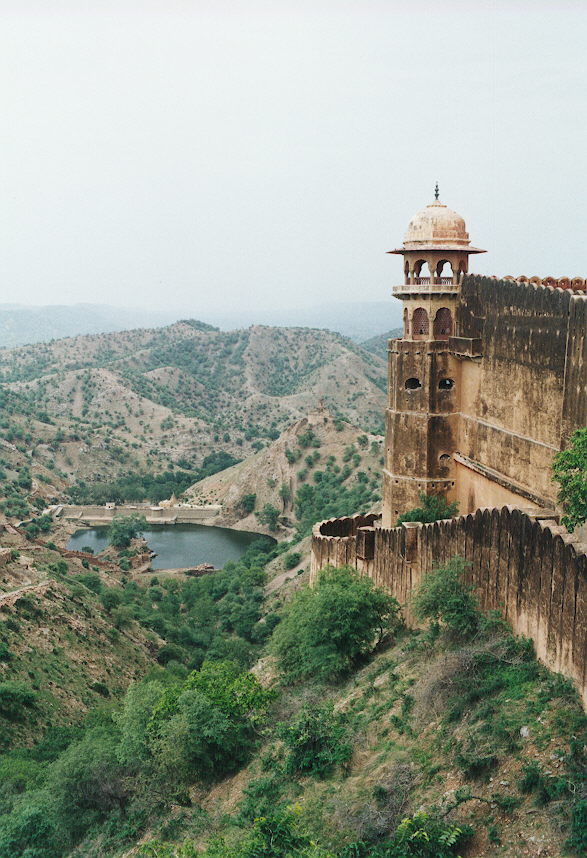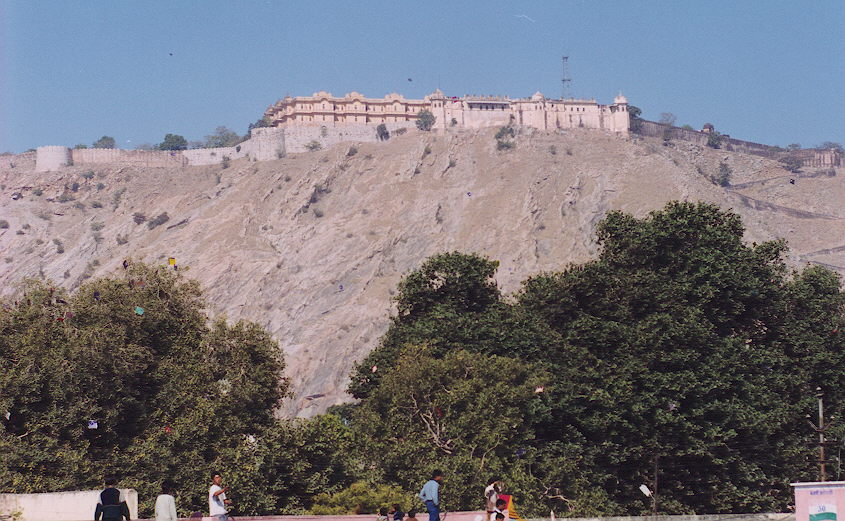
About 10 miles northeast of Jaipur lies the imposing Amber Fort. The name "amber" derives from the goddess Amba Mata (Mother Earth) worshiped by local tribes at the site prior to the building of the fort complex. It was established as a citadel in 1529 by Man Singh I on the remains of an 11th century fort, and much of its architectural beauty derives from later additions made by Jai Singh I. The Kachhawaha Rajputs (one of the three ruling warrior dynasties in Rajasthan) maintained the Amber Fort as their capital until moving to Jaipur in 1727. However, the fort retained its ceremonial value, as the rajas came to the Shila Devi Temple on religious occasions to pay their respects to the Mother Goddess. The Kachhawawaha Rajputs maintained their control of the region in part due to savvy alliances with the ruling Mughuls (most notably, Akbar) and the pleasure palaces within the fort reflect the Islamic influence.

 In addition to the Amber Fort (whose
features are shown in the virtual tour below), there are other
interesting sites to see. High above the Amber Fort lies the Jaigarh
Fort (photo to the left), whose ramparts follow the contours of the
hills and allowed defenders a choice of three different angles to fire
on would-be attackers. The fort also boasts the Jaivana cannon, the
largest of its kind in the world; it took four elephants to wheel it
around. Also near the Amber fort is the Nahargarh Fort, another in the
ring of fortresses defending the valley below, in which the city of
Jaipur is located. (photo to the right). Originally built as
another strategically located fort that could rain down cannon balls
and arrows on would-be attackers, by the 19th century the fort was
converted into a palace whose interior design resembles that of the
pleasure palaces of the Amber Fort
In addition to the Amber Fort (whose
features are shown in the virtual tour below), there are other
interesting sites to see. High above the Amber Fort lies the Jaigarh
Fort (photo to the left), whose ramparts follow the contours of the
hills and allowed defenders a choice of three different angles to fire
on would-be attackers. The fort also boasts the Jaivana cannon, the
largest of its kind in the world; it took four elephants to wheel it
around. Also near the Amber fort is the Nahargarh Fort, another in the
ring of fortresses defending the valley below, in which the city of
Jaipur is located. (photo to the right). Originally built as
another strategically located fort that could rain down cannon balls
and arrows on would-be attackers, by the 19th century the fort was
converted into a palace whose interior design resembles that of the
pleasure palaces of the Amber Fort

 Below the Amber Palace is
Maota Lake, which supplied water to the fort. Extending into the water
(well, during the rainy season, at least) are the gardens of Dilaram
Bagh (photo to the left) and Mohan Bari. The formal garden was a
Persian concept, brought to India by the Mughals, another indication of
the intimate relationship between the Mughals and the Kachhawaha
rajputs. Indeed, the Dilaram Bagh was built as a resting spot for the
Mughal leader Akbar. Dilaram Bagh, (meaning "heart's ease") is a
clever pun on the name of the architect, Dilaram. Nearby is
the Mohan Bari, another set of formal gardens (photo to the right).
Enroute to Amber from Jaipur lies the Jah Mahal, or Water Palace,
located on the lake of Man Sangar. Built by Madho Singh I, it was
inspired by the palace of Jag Mandir in Udaipur, where the raja spent
his childhood (photo below).
Below the Amber Palace is
Maota Lake, which supplied water to the fort. Extending into the water
(well, during the rainy season, at least) are the gardens of Dilaram
Bagh (photo to the left) and Mohan Bari. The formal garden was a
Persian concept, brought to India by the Mughals, another indication of
the intimate relationship between the Mughals and the Kachhawaha
rajputs. Indeed, the Dilaram Bagh was built as a resting spot for the
Mughal leader Akbar. Dilaram Bagh, (meaning "heart's ease") is a
clever pun on the name of the architect, Dilaram. Nearby is
the Mohan Bari, another set of formal gardens (photo to the right).
Enroute to Amber from Jaipur lies the Jah Mahal, or Water Palace,
located on the lake of Man Sangar. Built by Madho Singh I, it was
inspired by the palace of Jag Mandir in Udaipur, where the raja spent
his childhood (photo below).
Virtual Tour of the Amber Fort
Instructions: There are two ways to use this tour. You may place the mouse over the numbers in the illustration below, and the respective description page will open [note: this requires that adblock is turned off for this site]. If that does not work, please select the appropriately numbered box the table below and click on the link to open the page.

| 1. Suraj
Pol |
4. Diwan-I-Am |
7. Suk
Mandir |
| 2. Jaleb
Chowk |
5. Jas/Jai
Mandir |
8. Baradari |
| 3. Shila
Devi Temple |
6. Ganesh
Pol |
9. Zenana |
Air Pano's Aerial Tour of the Amber Fort
Instructions: to view aerial panoramas of the
features described in the tour above, select one of the first four
thumbnails on the left
side of the screen.